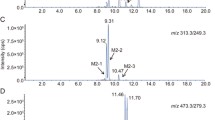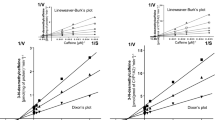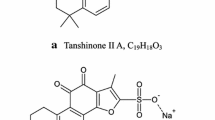Summary
The present study was carried out to characterize the human P450 isoforms involved in the metabolism of tandospirone, an anxiolytic agent known for its superior efficacy and safety. Among 11 yeast-expressed recombinant P450 isoforms tested, CYP2D6 and CYP3A4 exhibited the highest tandospirone metabolic activity. Although there was no qualitative difference between the two isoforms, a quantitative difference in metabolite profiling was found i.e., M4 (hydroxylation of the pyrimidine ring) was the major rnetabolite formed with CYP2D6 while M2 (hydroxylation of the norbornan ring) and 1-PP (oxidative cleavage of the butyl chain) predominated with CYP3A4. The metabolite profile on incubation with CYP3A4 was qualitatively and quantitatively similar to that obtained with human liver microsomes.In vitro intrinsic clearance (CLint) values derived from kinetic analysis using both P450 isoforms were similar (2.2 and 1.6 ml/min/nmol P450), but the hepatic content of CYP3A4 was found to be more abundant than that of CYP2D6. Thein vitro metabolism of tandospirone by human liver microsomes was markedly inhibited by ketoconazole (a CYP3A4 inhibitor) but not by quinidine (a CYP2D6 inhibitor). These results indicate that the metabolism of tandospirone by human liver microsomes primarily involves CYP3A4, and to a lesser extent CYP2D6.
Similar content being viewed by others
Change history
23 October 2019
The publisher has retracted this article [1] because it is an incorrect version that was published in error: Figures 5 and 6 are missing.
23 October 2019
The publisher has retracted this article [1] because it is an incorrect version that was published in error: Figures��5 and 6 are missing.
References
Shimizu H., Karai N., Hirose A., Tatsuno T., Tanaka H., Kumasaka Y., Nakamura M. (1988): Interaction of SM-3997 with serotonin receptors in rat brain. Jpn J. Pharmacol., 46, 311–314.
Shimizu H., Hirose A., Tatsuno T., Nakamura M., Katsube J. (1987): Pharmacological properties of SM-3997: a new anx-ioselective anxiolytic candidate. Jpn J. Pharmacol., 45, 493–500.
Kikuchi T., Goto Y., Suzuki J., Nagata H., Maeda S., Kanemoto S. (1992): Double-blind study of tandospirone (SM-3997) on essential hypertension as meaning of cardiovascular psychosomatic disease — Comparative study with diazepam. Clin. Rep., 26, 4351–4367.
Sasa M. (1997): A new approach to innovating selective anxiolytics: pharmacological profile of a novel 5-HT1A agonist (tandospirone). Jpn J. Psychopharmacol., 17, 53–59.
Mizuno Y., Iba K., Nakatsuka I., Yoshitake A. (1992): Absorption, distribution and excretion of SM-3997 in rats. Clin. Rep., 26, 1863–1883.
Mizuno Y., Iba K., Nakatsuka I., Yoshitake A. (1992): Metabolism of SM-3997. Clin. Rep., 26, 1885–1901.
Jones H.M., Houston J.B. (2004): Substrate depletion approach for determining in vitro metabolic clearance: time dependencies in hepatocyte and microsomal incubations. Drug Metab. Dispos., 32, 973–982.
Hutzier J.M., Walker G.S., Wienkers L.C. (2003): Inhibition of cytochrome P450 2D6: structure activity studies using a series of quinidine and quinine analogues. Chem. Res. Toxicol., 16, 450–459.
Patki K.C., Von Moltke L.L., Greenblatt D.J. (2003): In vitro metabolism of midazolam, nifedipine, and testosterone by human liver microsomes and recombinant cytochromes p450: role of CYP3A4 and CYP3A5. Drug Metab. Dispos., 31, 938–944.
Shimada T., Yamazaki H., Mimura M., Inui Y., Guengerich F.P. (1994): Interindividual variation in human liver cytochrome P-450 enzymes involved in the oxidation of drugs, carcinogens and toxic chemicals: studies with liver microsomes of 30 Japanese and 30 Caucasians. J Pharmacol. Exp. Ther., 270: 414–423.
Rodrfguez-Antona C, Donato M.T., Boobis A., Edwards R. J., Watts P.S., Castell J.V., Gómez-Lechón M.J. (2002): Cytochrome P450 expression in human hepatocytes and hepatoma cell lines: molecular mechanisms that determine lower expression in cultured cells. Xenobiotica, 32, 505–520.
Niwa T., Shiraga T., Ishii I., Kagayama A., Takagi A. (2005): Contribution of human hepatic cytochrome p450 isoforms to the metabolism of psychotropic drugs. Biol. Pharm. Bull., 28, 1711–1716.
Lamberg T.S., Kivistöo K.T., Neuvonen P.J. (1999): Lack of effects of terfenadine on the pharmacokinetics of the CYP3A4 substrate buspirone. Pharmacol. Toxicol., 84, 165–169.
Laine K., Ahokoski O., Huupponen R., Hänninen J., Palovaara S., Ruuskanen J., Björklund H., Anttila M., Rouru J. (2003): Effect of the novel anxiolytic drug deramciclane on the pharmacokinetics and pharmacodynamics of the CYP3A4 probe drug buspirone. Eur. J. Clin. Pharmacol., 59, 761–766.
Zhu M., Zhao W., Jimenez H., Zhang D., Yeola S., Dai R., Vachharajani N., Mitroka J. (2005): Cytochrome P450 3A-mediated metabolism of buspirone in human liver microsomes. Drug Metab. Dispos., 33, 500–507.
von Moltke L.L., Greenblatt D.J., Grassi J.M., Granda B.W., Fogelman S.M., Harmatz J.S., Kramer S.J., Fabre L.F., and Shader R.I., (1998): Gepirone and l-(2-pyrimidinyl)-piperazine in vitro: human cytochromes mediating transformation and cytochrome inhibitory effects. Psychopharmacology, 140, 293–299.
Greenblatt D.J., Von Moltke L.L., Giancarlo G.M., Garteiz D.A. (2003): Human cytochromes mediating gepirone biotransformation at low substrate concentrations. Biopharm. Drug Dispos., 24, 87–94.
Caccia S. (2004): Metabolism of the newest antidepressants: comparisons with related predecessors. Drugs, 7, 143–150
Kivistö K.T., Lamberg T.S., Kantola T., Neuvonen P.J. (1997): Plasma buspirone concentrations are greatly increased by erythromycin and itraconazole. Clin. Pharmacol. Ther., 62, 348–354.
Lamberg T.S., Kivistö K.T., Laitila J., Martensson K., Neuvonen P.J. (1998): The effect of fluvoxamine on the pharmacokinetics and pharmacodynamics of buspirone. Eur. J. Clin. Pharmacol., 54, 761–766.
Lilja J.J., Kivistö K.T., Backman J.T., Lamberg T.S., Neuvonen P.J. (1998): Grapefruit juice substantially increases plasma concentrations of buspirone. Clin. Pharmacol. Ther., 64: 655–660.
Lamberg T.S., Kivistö K.T., Neuvonen P.J. (1998): Concentrations and effects of buspirone are considerably reduced by rifampicin. Br. J. Clin. Pharmacol., 45, 381–385.
Kivistö K.T., Lamberg T.S., Neuvonen P.J. (1999): Interactions of buspirone with itraconazole and rifampicin effects on the pharmacokinetics of the active 1-(2-pyrimidinyl)-piperazine metabolite of buspirone. Pharmacol. Toxicol., 84, 94–97.
Masui T., Kusumi I., Takahashi Y., Koyama T. (2006): Effects of itraconazole and tandospirone on the pharmacokinetics of perospirone. Ther. Drug. Monit., 28, 73–75.
Kitamura A., Mizuno Y., Natsui K., Yabuki M., Komuro S., Kanamaru H. (2005): Characterization of human cytochrome P450 enzymes involved in the in vitro metabolism of perospirone. Biopharm. Drug Dispos., 26: 59–65.
Author information
Authors and Affiliations
Additional information
The publisher has retracted this article because it is an incorrect version that was published in error: Figures 5 and 6 are missing. Prior to Springer Nature becoming the publisher of this journal, a corrected version of the article was published, but regrettably the first version was not simultaneously retracted to correct the scholarly record, resulting in a duplicate publication. We apologise to the authors and to readers. All authors agree to this retraction.
About this article
Cite this article
Natsui, K., Mizuno, Y., Tani, N. et al. RETRACTED ARTICLE: Identification of CYP3A4 as the primary cytochrome P450 responsible for the metabolism of tandospirone by human liver microsomes. European Journal of Drug Metabolism and Pharmacokinetics 32, 131–137 (2007). https://doi.org/10.1007/BF03190475
Received:
Published:
Issue Date:
DOI: https://doi.org/10.1007/BF03190475




